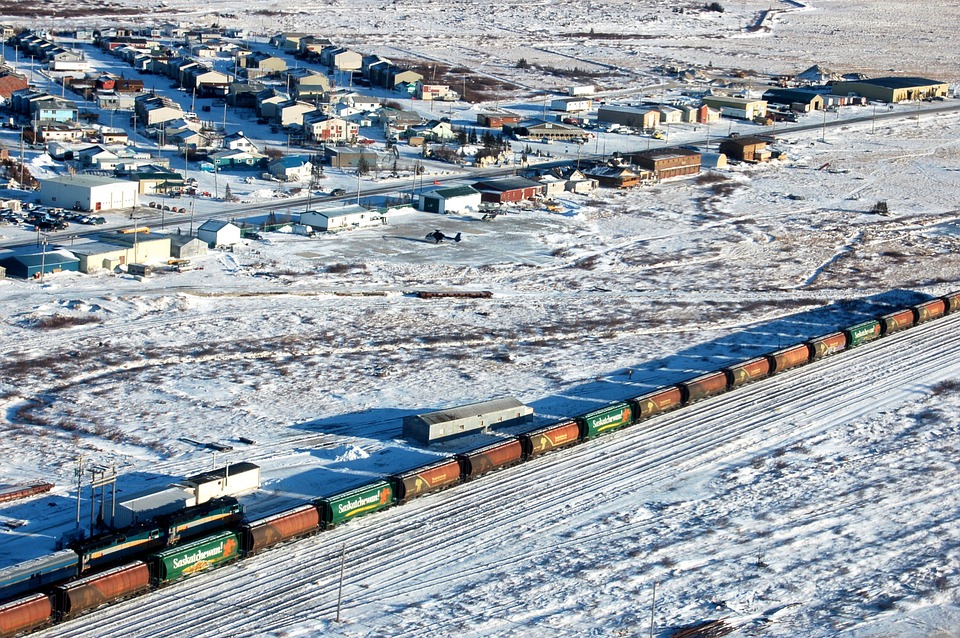Officials are still scrambling to fix a rail link to Canada’s deepwater Arctic port

Seven months after flooding damage to a rail link cut off land access from southern Canada to Churchill. Manitoba — Canada’s only deepwater Arctic port — government and business officials are still trying to find a permanent solution.
Earlier this month, the federal government announced $2.7 million more in economic stimulus funding for the town.
“The federal government continues to recognize the importance of the Hudson Bay Railway Line and Port of Churchill to communities in northern Manitoba and in the Kivalliq Region of Nunavut,” says a government press release issued Dec 1.
Since the shutdown, the government subsidized Churchill’s food supply and formed an economic development fund to help the town deal with reductions to tourism and expediting businesses due the rail closure.
[What a rail link — and its loss — has meant to Churchill, Manitoba]
Niki Ashton, federal Member of Parliament for Churchill says that the closure has been “devastating” to her constituents. She says “It’s been a shock” to people in her riding that have lost their livelihoods and the quality of life that they previously knew.
The rail line leads to Canada’s only Arctic deep sea port in Churchill but the port is currently closed because low demand for shipments means it’s no longer financially viable, according to OmniTRAX, its Denver-based owner.
The port and the rail line — which were publicly owned until their privatization in 1997 — were once important for the shipment of Canadian grain to overseas markets but the end of the government wheat board in 2015 meant farmers found it more advantageous to ship their product through southern Canadian ports.
Wheat made up to 90 percent of the port’s business but the port was also important for the resupply of communities in Canada’s central and western Arctic. Hamlets in those regions lack road access so bulk goods, including the diesel fuel on which most Arctic communities are dependent, must be supplied by ship in the summer ice-free shipping season or be shipped by costly air freight.
John Main, an elected territorial representative from Nunavut’s central Arctic region says that the rail shutdown has not noticeably increased prices in his region but he foresees the possibility of increases as retailers pass on rising costs. Manitoba-Nunavut business ties are important he says but these relationships “have suffered and will continue to deteriorate if the line continues to languish.”
OmniTRAX says it can’t afford to repair the rail line and that the floods were a “force majeure” which relieves the company of its contractual obligation to keep the line open. In November the federal government served OmniTRAX with a lawsuit.
Responding to the lawsuit, Max Tweed, OmniTRAX Canada’s president, blamed governments for the line closure.
“It appears from their collective indecisiveness, dysfunction and lack of leadership on this critical issue that both Canada and the Province of Manitoba are content to leave Churchill as a remote, fly-in community for the first time in over 100 years” said Tweed in a press release. The company also filed a counterclaim under the North American Free Trade Agreement alleging that closing the wheat board was an unfair trade practice that hurt the business of the company.
In addition to the lawsuit and claim, the Canadian Transportation Agency, a regulatory body, is conducting an investigation into the closure of the line. The investigation started on October 27. A normal timeline to complete such an investigation is 85 business days. The agency can order OmniTRAX to take “measures to address service failures” in “any manner and within any time or during any period that the Agency deems expedient” according to Canada’s Transportation Act.
The legal actions come during negotiations to sell OmniTRAX to a consortium of First Nations and other entities operating along the line. In November the federal government announced that Toronto-based Fairfax Financial Holdings Ltd. expressed interest in a partnership with the group.
Through an emailed statement from OmniTRAX’s public relations firm, a company representative says it has yet to be contacted by Fairfax though it would “welcome a sale that would provide fair value for the assets and a solution for the people of Churchill.”
The government says it will support the sale if the new owner “has support from First Nations and other communities along the route” and “has a viable business plan to operate the rail line reliably and cost-effectively” adding that the sale be at “a reasonable price and taking into account OmniTRAX’s obligations.”
Ashton says she would prefer that the government re-nationalize the rail line, calling privatization an “abject failure.”
Though a federally owned line is her first choice, she would support an ownership scheme that would result in the line coming under local control. People living along the line are angry about how the subsidized private line has been operated since 1997 and are saying that they’ve been “held hostage by OmniTrax” she said.
As for when the line will be repaired, the government responded that they’re working with all the parties “towards a sustainable, long-term outcome that will benefit the people and communities of northern Manitoba.”